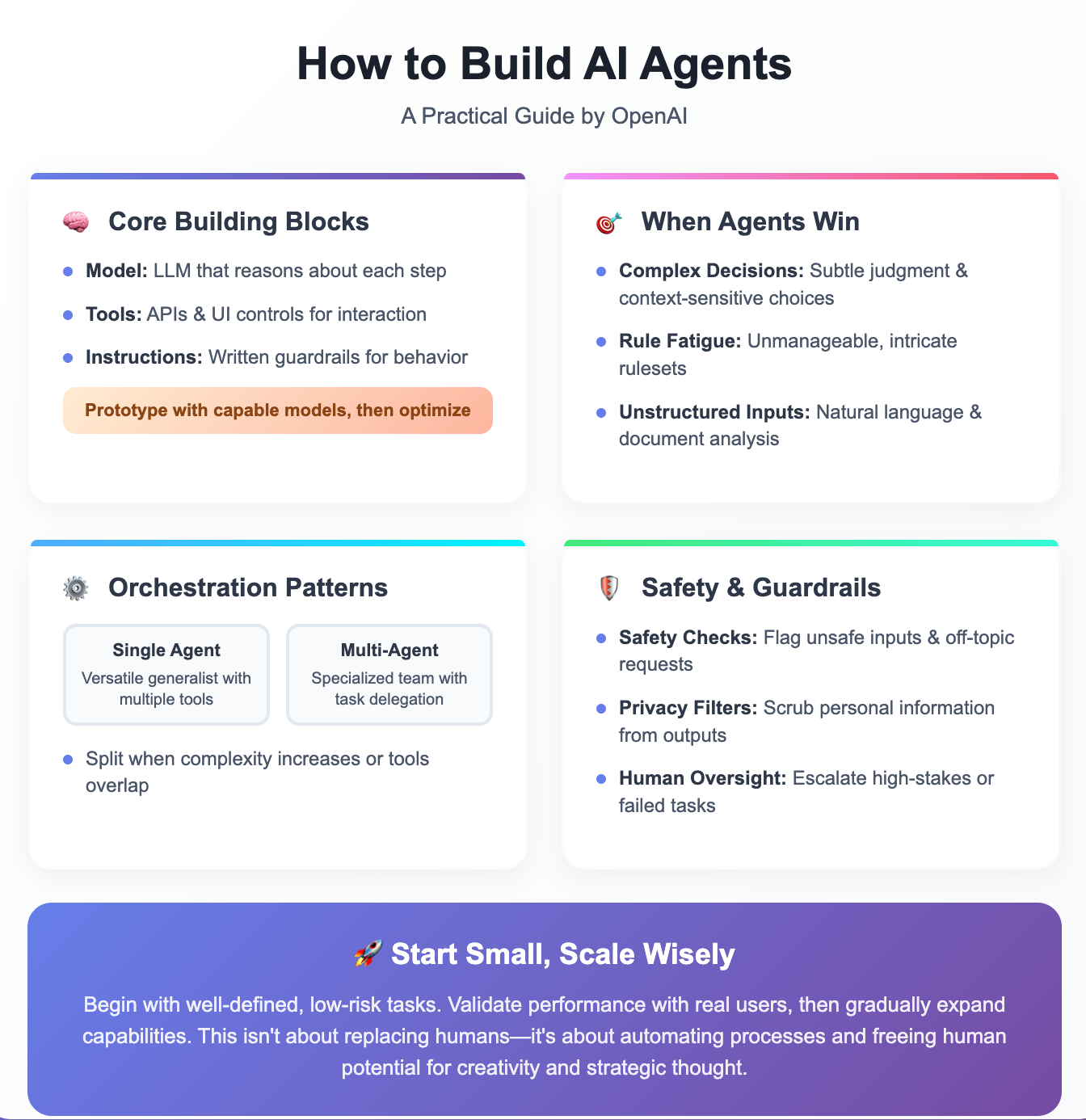Large language models (LLMs) have quietly crossed a threshold when, instead of only answering questions, these AI systems can plan, decide, and act, stringing together many steps the way a human expert. This new frontier in software innovation, known as autonomous AI agents, is already handling customer claims, analyzing market intel, and even writing code fixes without humans needing to constantly monitor it. AI agents do it by blending reasoning, memory, and tool-use in ways that yesterday's chatbots never could, unlocking whole workflows that were once too messy to automate.
Why Agents Are the Talk of the Tech World
Most large language models and generative AI tools today are helpful but limited, confined to answering questions, organizing schedules, or running simple tasks within tightly defined parameters. AI agents, on the other hand, are different because they don't just automate; they can reason and act (ReAct) on your behalf, adapting to complex situations and managing multi-step tasks with an autonomy we've never seen before.
What exactly is an AI Agent?
Think of an agent as software that doesn't wait for you to click every button. It accepts a goal ("refund that order," "translate this brief," "update the CRM"), chooses its own sequence of actions, and knows when the job is finished or when to hand control back to a human. AI agents stand apart from rules engines and one-shot chat completions because they manage the workflow end-to-end and can correct themselves mid-task.
What Sets AI Agents Apart?
- LLM-driven decision making: AI agents use modern large language models (LLMs) for reasoning, so they can handle ambiguity, process unstructured natural language, and make context-sensitive choices.
- Dynamic tool use: AI agents are equipped with a toolbox of APIs, software actions, and data sources, and can fluidly choose and combine these tools to accomplish tasks.
- Workflow ownership: Instead of just responding, AI agents can take charge, deciding when a workflow is finished, what to do next, and how to recover if things go wrong.
- Flexible orchestration: Whether it's a single AI agent managing all steps or a team of specialized agents handing off tasks, the architecture adjusts to fit the workflow.
- Continuous learning: Built-in evaluation and guardrails keep AI agents improving and behaving responsibly as they encounter edge cases and real-world challenges.
When Does an Agent Beat Traditional Automation?
There are three sweet-spot scenarios where AI agents outperform traditional automation. They are,
- Complex decisions: Workflows involving subtle judgment, exceptions, or context-sensitive decisions, for example, refund approval in customer service workflows.
- Rule fatigue: Systems that have become unmanageable due to extensive and intricate rulesets, making updates costly or error-prone, for example, conducting vendor security reviews.
- Unstructured inputs: Scenarios that involve understanding and analyzing natural language, extracting meaning from documents, or interacting with users conversationally, for example, processing a home insurance claim.
If your use case doesn't hit at least one of those pain points, a simpler script might be cheaper and safer.
How to build an autonomous AI agent?
Autonomous AI agents are no doubt the future; however, building an AI agent isn't as easy as it may seem. Fortunately, OpenAI quietly released a comprehensive practical guide on how to build AI agents. Within its technical pages is a clear blueprint for the future of work and business automation.
It reveals that creating a reliable AI agent is less about a single, magical algorithm and more like hiring, training, and managing a new kind of employee. It's a discipline that balances power with safety, and autonomy with human oversight. For anyone in business, technology, or simply curious about where AI is really going, understanding this blueprint is no longer optional.
At their core, AI agents share three building blocks:
- Model: The large language model (LLM) that reasons about each step.
- Tools: APIs or UI controls that the AI agent can use.
- Instructions: The written guardrails that shape its behavior.
How to Build AI Agents:
The Model: A Core Engine
This is the brain of the operation, an LLM that provides the reasoning and decision-making capabilities. You might use a highly capable model for complex tasks (like deciding whether to approve a complex insurance claim) and a smaller, faster model for simple tasks (like identifying the user's initial request).
A practical tip from the field: Prototype with the most capable model you can afford, establish a performance baseline, then swap in lighter models where they meet the same accuracy bar. That sequence avoids premature optimization and reveals which steps truly need heavyweight reasoning.
A Set of Tools:
AI agents are given access to tools that allow them to interact with the outside world. These aren't physical tools, but connections to software, databases, and APIs.
These tools fall into three categories:
- Data tools for gathering data (like searching a customer database or reading a PDF),
- Action tools for taking action (like sending an email or updating a CRM).
- Orchestration tools that let AI agents serve as tools for other agents
Clear Instructions
This is one of the most critical components. You can't just tell an AI agent to "handle customer service." You must provide explicit, high-quality instructions that define its role, its boundaries, and how it should behave, including everything from its personality to the specific steps it should follow when a user provides incomplete information.
Orchestrating the Work
AI gents can work alone or as part of a team. Agent systems typically follow one of two patterns:
- Single-Agent system: This type of AI system is like a versatile generalist equipped with several tools and instructions needed for different tasks that runs until it reaches an exit condition. This approach keeps complexity low by simply adding tools as the use case expands.
- Multi-agent system: A multi-agent network is a team of specialized AI agents that hand tasks to each other. A manager agent that first assesses a user's request and then delegates it to a specialized agent, such as a "refund agent" or a "technical support agent."
When your all-in-one agent starts tripping over overlapping tools or tangled conditional logic, it's time to split the workload. Practical heuristics include breaking apart prompts with many if-then branches and offloading clusters of similar tools to their own agents.
Guardrails: Keeping AI Agents Safe and Sound
With great power comes great responsibility. To operate safely, AI agents need strong guardrails. These are layered defenses that prevent them from going off the rails. This includes:
- Relevance and safety checks: Classifiers flag off-topic requests, unsafe inputs, or attempts to trick the AI agent.
- Personal information filters: Scrub outputs to avoid leaking customer details.
- Moderation: Root out abusive or inappropriate content before it reaches a human.
- Risk-based tool gating: Important actions like issuing refunds or deleting data have extra safety checks or need approval from a person.
- Rules-based filters: Regular expressions, blocklists, and limits on length help keep known threats away.
The OpenAI framework encourages optimistic execution: Let the AI agent act quickly while guardrails monitor in parallel and stop only when something looks risky. Pair that with a human-in-the-loop plan, triggered by repeated failures or high-stakes moves, and you balance speed with accountability.
Human Oversight:
An important and reassuring aspect of AI agent design is the plan for human intervention. AI agents are not meant to be unfailing black boxes. When an AI agent is unable to resolve an issue after a few attempts or when a task is too sensitive or high-stakes, the system should be designed to escalate the problem to a human for a final decision.
Start Small, Scale Wisely
The recommendation is to start small, perhaps with a single agent handling a well-defined, low-risk task. After validating its performance with real users, a business can gradually expand the agent's capabilities, adding more tools or evolving into a multi-agent team only when the complexity demands it.
This iterative approach is important. It allows for the finding of edge cases and the improvement of the agent's instructions and guardrails in a controlled way. The goal is not to build a fully autonomous, all-powerful system overnight, but to grow its capabilities over time, building trust and ensuring it operates safely and predictably.
In Conclusion:
AI agents promise a future where business processes aren't just automated, they're intelligent by combining smart decision-making, dynamic tool use, and robust safety nets. Start small, measure often, and add complexity only when it buys real usefulness. This isn't about replacing humans, but about automating entire processes, freeing up human potential for tasks that require genuine creativity, empathy, and strategic thought. The blueprint is here, and the organizations that learn to use it will be the ones to define the future of work.



